|
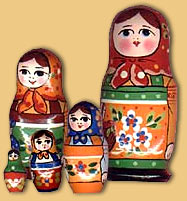 The
traditional symbol of russian culture is Matreshka (also spelled
Matryoshka), which is a set of nesting dolls. Most of them
are exclusive author's works made by famous russian artists. The
traditional symbol of russian culture is Matreshka (also spelled
Matryoshka), which is a set of nesting dolls. Most of them
are exclusive author's works made by famous russian artists.
Every doll (except the last one, the smallest) consists
of two parts. The smaller doll inserts into the bigger one.
Thus dolls (sometimes up to 30) can be combined inside the
biggest doll - Matreshka. Production of a 30-pieces Matreshka
demands a huge amount of time and effort. The size of the
biggest doll is about 15 inches whereas the smallest - 0,1
inches!
This is very high detailed unique work.
|
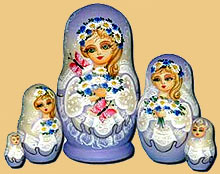 Before
the painter starts his work the wood turner makes a "part blank".
Every doll is turned by hand with lathe. All dolls are made
from natural wood. After the pictures are ready, dolls are covered
by the several layers of the lacquer. The lacquer adds glint
to the doll and defends the pictures. Before
the painter starts his work the wood turner makes a "part blank".
Every doll is turned by hand with lathe. All dolls are made
from natural wood. After the pictures are ready, dolls are covered
by the several layers of the lacquer. The lacquer adds glint
to the doll and defends the pictures.
You can find dolls, which illustrate the Bible stories,
fairy tales, famous poems, the views of natural landscapes and
Russian life-style. If you deal directly with the artists you
can order a custom made dolls, made from the family photos or
paintings.
|
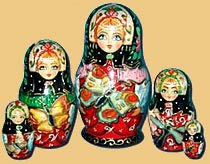 Matreshka
Is a wooden doll, usually in a colorful dress with successively
smaller ones fitted into it. The doll is generally recognized
as a symbol of Russian national art. The predecessor of this
Russian doll was brought to Russia from the island Honshu. Matreshka
Is a wooden doll, usually in a colorful dress with successively
smaller ones fitted into it. The doll is generally recognized
as a symbol of Russian national art. The predecessor of this
Russian doll was brought to Russia from the island Honshu.
The Japanese affirm that it was an unknown Russian monk
who carved the first doll of this kind on island. The first
Russian matreshka appeared in the late XIX century. The female
name Matrena, Matresha was wide-spread in pre-Revolutionary
provinces. It derives from the Latin word "mater".
The name is associated with a mother of large family who has
good health and a corpulent figure. For the first time the quantity
production of this doll was organized near Moscow
in Sergiev Posad. The style of Russian matreshka painting was
greatly influenced by icon-painters of Sergiev Posad.
|
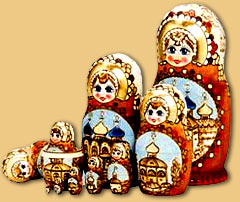 First Matreshkas costume was in tender pastel colors
and reflected the major style of that period. The variety of
nesting dolls was achieved by the number of pieces mainly ranging
from 3 to 12. But also exist "supermatreshkas" having
48-60 pieces, but these are unique.
First Matreshkas costume was in tender pastel colors
and reflected the major style of that period. The variety of
nesting dolls was achieved by the number of pieces mainly ranging
from 3 to 12. But also exist "supermatreshkas" having
48-60 pieces, but these are unique.
|
 The
painting of Matreshkas awakes the creative potential of various
artists. Nowadays authors of Matreshka use the themes of Russian
and European paintings, landscape painting and still life. Some
of them have ornaments based on the plots of popular European
fairy tales. The
painting of Matreshkas awakes the creative potential of various
artists. Nowadays authors of Matreshka use the themes of Russian
and European paintings, landscape painting and still life. Some
of them have ornaments based on the plots of popular European
fairy tales.
In spite of this fact Matreshka stays Russian national
souvenir with Russian history and traditions. This wooden doll
decorates any place it appears and keeps the warmth of the hands
of the craftsman.
|
|
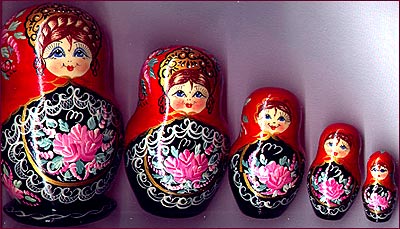
The Museum Of Russian Matreshka was opened in Moscow
in October 2001. It is the first official collection of Matreshka
dolls in Russia, in spite of this art exists in Russia more
than 100 years and appears as the most popular Russian craft.
The Matreshka Museum accommodates in the building of Russian
Folk Arts Fund, in the same house where the first Russian
Matreshka doll was created in the end of the XIX century.

|
|
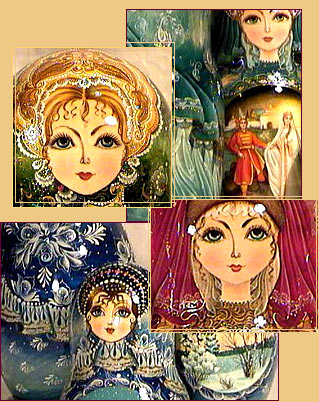 |

|
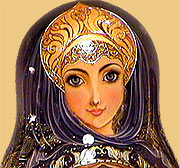 Sergiev
Posad Sergiev
Posad
Sergiev Posad was a place where the first nesting doll
was made.
This old Russian town is located 73 km (about 45 miles) from
Moscow.
The town emerged long time ago, round the St. Trinity
Sergius Lavra, the monastery established here by one of the
most honoured Russian saints, reverent Sergius of Radonezh.
|
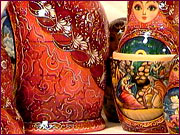 In
1340 the monk Sergius founded a small temple lost in the midst
of the wild thick forests. In time it was developed into the
biggest monastery of Russia. In
1340 the monk Sergius founded a small temple lost in the midst
of the wild thick forests. In time it was developed into the
biggest monastery of Russia.
Arts and crafts were flourished in the towns and villages who
surrounded the monastery. Wooden toys, which were known as "Trinity"
toys, became particularly popular. According to the legend the
first "Trinity" wooden toy was made by the Sergius
Radonezhsky himself.
Sergiev Posad was a colorful, truly Russian town. The
Monastery lent a unique peculiarity to it. The huge marketplace
in front of the Monastery was almost always full of different
people: merchants, monks, pilgrims and craftsmen were milling
around.
|
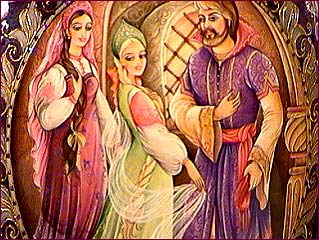
|
|
Professional artist made the first painted matreshka
of Sergiev Posad just for fun. That is why these dolls are
so expressive and won admiration of adults and children. In
the initial period of matreshka development particularly attention
was paid to faces of matreshka, clothes were not detailed
painted. Such dolls depicted different character and types:
peasants, merchants, and noblemen. Along with the icons, matryoshkas
were painted as well in the icon painting school of Sergiev
Posad.
In spite of, or perhaps because of the popularity
of the matryoshkas of Sergiev Posad, matryoshka-making center
started to spring up in Russia.
|
|



